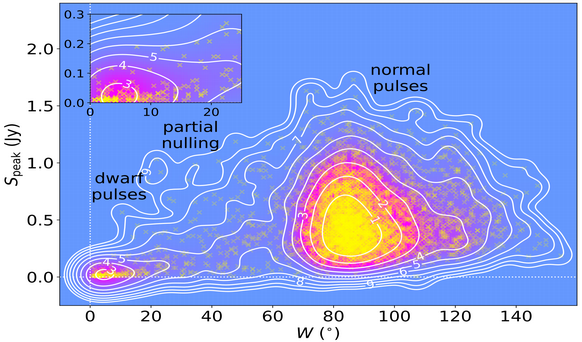
China's FAST telescope detects distinct dwarf pulses from a bright pulsar PSR B2111+46. /NAOC
China's FAST telescope detects distinct dwarf pulses from a bright pulsar PSR B2111+46. /NAOC
Chinese scientists have detected distinct "dwarf pulses" from a bright pulsar using the Five-hundred-meter Aperture Spherical Radio Telescope (FAST), the world's largest single-dish telescope.
Led by Han Jinlin, a researcher at the National Astronomical Observatories of the Chinese Academy of Sciences (NAOC), the team studied their radio emission and probed the unknown physics in the magnetosphere.
A relative study was published in the journal Nature Astronomy on August 17.
Pulsars generally emit periodic radio signals. However, some old pulsars occasionally quench for some periods, a phenomenon known as "pulse nulling."
The exact reason for the absence of pulsar radiation is a mystery because it is impossible to probe the physical state of the pulsar magnetosphere when radiation is quenched, according to the NAOC.

A screenshot of the study published in the journal Nature Astronomy on August 17, 2023.
A screenshot of the study published in the journal Nature Astronomy on August 17, 2023.
Scientists have long known that emission from PSR B2111+46, a relatively old pulsar, often nulls for periods of time.
However, dozens of unusually weak and very narrow pulses – previously unobserved – were detected during ordinary nulling periods when they were serendipitously observed in 2020.
To verify this new kind of emission state, researchers observed this pulsar for two hours again in 2022.
"Finally, we picked out 175 such narrow, weak pulses," said Chen Xue, the first author of the study.
According to Chen, such pulses stand out from normal pulses in terms of pulse width and energy. They have been named "dwarf pulses."
Normal individual pulses emit radiation through a "thunderstorm" of particles produced by copious discharges in regularly formed gaps near the pulsar's magnetic poles. Dwarf pulses, on the other hand, are produced by one or a few "raindrops" of particles generated by pair production in a fragile gap of this near-death pulsar.

Dwarf pulses from pulsar B2111+46 exhibit distinct differences in pulse width and radiation energy compared to normal pulses. /NAOC
Dwarf pulses from pulsar B2111+46 exhibit distinct differences in pulse width and radiation energy compared to normal pulses. /NAOC
These sporadic, weak and narrow pulses constitute a new radiation state independent of normal pulses, and such pulses have much stronger emission at higher radio frequencies, which is rarely detected in such a distinguished timescale from astronomical sources, said the NAOC.
"The properties of such dwarf pulses would be hard to be measured by other radio telescopes than FAST," said Han, adding that measurements of such a new population of dwarf pulses reveal that the magnetic field structure for the pulsar radiation remains unchanged even when the radiation is almost ceased.
NAOC said that researchers also detected a smaller number of dwarf pulses under the pulse nulling state from a few other pulsars.